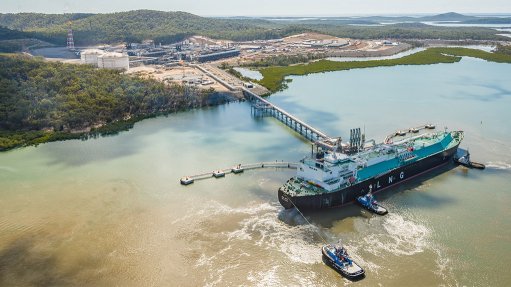Kumba Iron Ore feeling tailwind of two-year wage agreement

Kumba Iron Ore CEO Norman Mbazima tells Mining Weekly Online’s Martin Creamer that the company will be using technology in a bid to recover iron from low-grade material. Photographs and Video: Duane Daws. Video Editor: Darlene Creamer
JOHANNESBURG (miningweekly.com) – Iron-ore miner Kumba Iron Ore is feeling the tailwind of its two-year wage agreement.
The JSE-listed Anglo American-group company, which concluded a two-year wage agreement in July 2012, will not have to negotiate remuneration at a time when the employee relations in the mining sector remain difficult.
In terms of the agreement, the company’s 12 651 employees automatically receive pay rises of from 8% to 10%.
Kumba CEO Norman Mbazima on Tuesday described as stable the labour environment that the company had experienced in the first half of this year.
“We are fortunate to not have been affected by the labour unrest,” Mbazima said at the company’s presentation of results, adding that the company had completed the first half of the year with no loss of life incidents.
Kumba this year spent R310-million on new homes for its employees, bringing the total spend on housing since 2006 to R2.2-billion.
Moreover, more than 6 000 worker shareholders each became pretax half-millionaires last year when R2.7-billion was paid out to staff in the first phase of an employee share ownership plan (Esop).
Sishen Iron Ore Company (SIOC) Community Development Trust, in the half-year used its dividend to fund 140 projects worth R850-million, benefiting 360 000 people in the five communities around Kumba’s mines.
In addition, Kumba will be spending R77-million on early childhood, skills, enterprise and infrastructure development for near-mine communities.
Only six months ago, however, Kumba’s Northern Cape operations were rocked by unprotected strikes, which led to dismissals and replacement recruitment has only now been completed.
This time six months ago, people were asking how employees who had made so much money as shareholders could go on strike.
“Just remember, it was a small number of people who went on strike, and not the entire workforce,” Mbazima told Mining Weekly Online in a video interview (see attached).
Any day now, each employee that is part of the Esop will receive another interim dividend; this time R12 000 in cash.
“My number one priority is to make sure that my employees are happy, that we are happy and that we are all productive,” Mbazima said.
EMPOWERMENT BONANZA
Kumba continues to make a significant contribution to South Africa’s broad-based black economic empowerment (BBBEE) through both capital appreciation and the payment of substantial cash dividends to empowerment shareholders.
SIOC, in its interim dividend for 2013, will return a further R2.3-billion to its BBBEE shareholders, bringing the total returned since listing in 2006 to more than R19-billion.
The JSE-listed black-controlled Exxaro, which confers black economic-empowerment credentials on Kumba, will receive R1.8-billion for its 20% interest in SIOC.
In the six months, the community development trust that owns 3% of SIOC and which is valued at more than R6-billion, received R262-million for its community development projects.
SISHEN’S DOWNSIDE RISK
Sishen has had a few issues over the years.
The mine is earmarked to produce at a rate of 37-million tons a year, but its openpit is currently constrained.
Kumba is finding it “very challenging” to meet the production marker following the last year's fourth-quarter strike, and Mbazima is warning of a downside risk in the near-to-medium term.
Coming to the rescue is the new Kolomela, where there is potential to increase production beyond the nine-million-tons-a-year level from the current pits.
In addition, ways of turning lower-cost Northern Cape production to account are being considered, for example, a reconfiguration of the Kolomela mine to make its output incremental rather than a single additional step of six-million tons a year.
Sishen’s geology and mining are being continually reviewed and costs are poised to rise there to provide increased flexibility in the pit.
“We’ve done an extensive review of Sishen now and I think we’re getting to the bottom of it,” Mbazima told Mining Weekly Online.
Pit limitations knocked 10% off Sishen’s production in the half year, reducing it to 16-million tons.
Considerable B-grade Sishen resource has been relegated to even lower C-grade resource, for which metallurgical capacity is not available to convert to sellable product.
“We’re looking at a number of technologies and one of them is very promising,” Mbazima told Mining Weekly Online, adding that it was not long ago that B-grade material was turned to very positive account with the help of jig technology.
State-owned rail provider Transnet has proved highly efficient in its dealings with Kumba.
“The port had a few maintenance issues but everything sent there was shipped,” he added.
THE BIG OPPORTUNITIES
The first big opportunity for Kumba is to deliver on its growth projects in the Northern Cape and Limpopo.
The second is to look for a second footprint in Africa because in 18 years’ time Sishen will have been depleted and will need replacing.
The third is to find the technology to turn the C-grade material into saleable product.
LEGAL TUSSLES
Kumba is involved in six legal disputes, the most noted being its legal issues with the Department of Mineral Resources (DMR), Imperial Crown Trading (ICT) 289 and steelmaker ArcelorMittal South Africa (AMSA).
On September 3, the DMR and ICT will ask the Constitutional Court of South Africa to set aside North Gauteng High Court and Supreme Court of Appeal (SCA) judgements that give Kumba’s SIOC full rights to the Sishen mine.
A dispute also arose between SIOC and AMSA in February 2010, in relation to SIOC’s contention that the contract mining agreement concluded between them in 2001 had become inoperative as a result of AMSA failing to convert its old-order mining rights.
This dispute has been referred to arbitration but the hearing of the arbitration has been postponed until after the final resolution of the DMR and ICT mining rights dispute.
The sale of iron-ore from the Sishen mine to AMSA currently remains regulated in terms of an interim pricing agreement concluded in December 2012 and applies to the period from January 1 to December 1, 2013, or finalisation of the arbitration, whichever is sooner.
A dispute also exists between AMSA and SIOC about AMSA’s contention that SIOC must supply it with iron-ore produced from the Phoenix project in Thabazimbi.
AMSA referred this to arbitration in February and SIOC is continuing to engage with AMSA on this matter.
Another dispute declared by AMSA centres on historical cost recovery by SIOC at Sishen, which Kumba intends defending.
In another matter, Lithos Corporation is claiming $421-million from Kumba for damages at the Falémé project in Senegal; but on April 9 this year Kumba’s application for absolution was upheld and the Lithos' claim dismissed with costs.
On June 18, Lithos launched an application to apply for leave to appeal to the SCA, which Kumba will oppose.
Kumba initiated arbitration proceedings against La Société des Mines de Fer du Sénégal Oriental, or Miferso, and the State of Senegal under the rules of arbitration of the International Chamber of Commerce in 2007, in relation to the Falémé project.
Following the arbitration award on July 2010, a mutually agreed settlement was concluded, but that settlement was revised in June this year, when parties agreed that the terms would remain confidential.
“I would like to see progress on bringing all these to a resolution,” Mbazima commented to Mining Weekly Online.
Kumba's operations generated cash of R17-billion in the six months to June 30. The company returned R5.1-billion to shareholders, the biggest being Anglo American, and paid R3.6-billion to the South African government in income taxes and mineral royalties.
The company expects to invest up to R6-billion capital expenditure this financial year, after spending R2.3-billion in the first half.
Comments
Press Office
Announcements
What's On
Subscribe to improve your user experience...
Option 1 (equivalent of R125 a month):
Receive a weekly copy of Creamer Media's Engineering News & Mining Weekly magazine
(print copy for those in South Africa and e-magazine for those outside of South Africa)
Receive daily email newsletters
Access to full search results
Access archive of magazine back copies
Access to Projects in Progress
Access to ONE Research Report of your choice in PDF format
Option 2 (equivalent of R375 a month):
All benefits from Option 1
PLUS
Access to Creamer Media's Research Channel Africa for ALL Research Reports, in PDF format, on various industrial and mining sectors
including Electricity; Water; Energy Transition; Hydrogen; Roads, Rail and Ports; Coal; Gold; Platinum; Battery Metals; etc.
Already a subscriber?
Forgotten your password?
Receive weekly copy of Creamer Media's Engineering News & Mining Weekly magazine (print copy for those in South Africa and e-magazine for those outside of South Africa)
➕
Recieve daily email newsletters
➕
Access to full search results
➕
Access archive of magazine back copies
➕
Access to Projects in Progress
➕
Access to ONE Research Report of your choice in PDF format
RESEARCH CHANNEL AFRICA
R4500 (equivalent of R375 a month)
SUBSCRIBEAll benefits from Option 1
➕
Access to Creamer Media's Research Channel Africa for ALL Research Reports on various industrial and mining sectors, in PDF format, including on:
Electricity
➕
Water
➕
Energy Transition
➕
Hydrogen
➕
Roads, Rail and Ports
➕
Coal
➕
Gold
➕
Platinum
➕
Battery Metals
➕
etc.
Receive all benefits from Option 1 or Option 2 delivered to numerous people at your company
➕
Multiple User names and Passwords for simultaneous log-ins
➕
Intranet integration access to all in your organisation



















